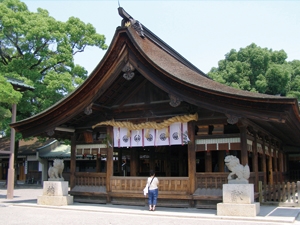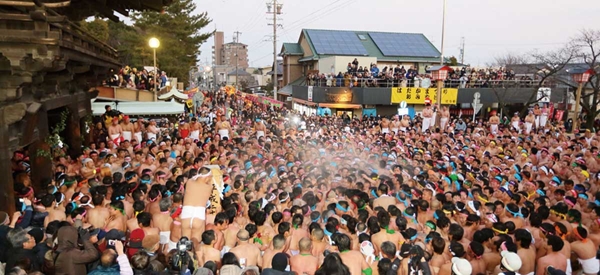- HOME
- Search in the site
- Owari Okunitama Shrine (Konomiya)

Owari Okunitama Shrine (Konomiya) is nationally famous for its Hadaka Matsuri. Widely worshiped as a shrine to the Owari region's grand guardian deity, tutelary deity of agriculture and business, and deity of pestilences, Owari Okunitama Shrine was designated as a "soja" shrine enshrining several deities in the Owari Province. The "kokushi" (provincial governor) was able to perform his own religious services because in the Nara period, the shrine stood right next to the "kokuga" (kokushi's office). Therefore, the shrine is generally referred to as the Konomiya Shrine or Konomiya.
In the precincts are the main shrine, connecting corridor, liturgy hall, east and west cloisters, front shrine (important cultural property), and the sakura-gate (important cultural property), and also there is a hidden place beside the main shrine called the "Iwakura" where five large natural stones are laid down in a circle. This is a primitive ceremonial site that was used before today's shrine buildings were built, which suggests how old it is.
Baring All at Konomiya Jinja Shrine’s Naked Festival


Every freezing cold February, thousands of warmly dressed spectators line the avenue to the ancient Konomiya Shrine to watch hundreds of naked men perform the Hadaka Matsuri, the Naked Festival. Hundreds of men, their manhood barely concealed by light, white, cotton loincloths, are splashed with cold water as they carry portable shrines, or try to touch the “Lucky Man” as he makes his way to the inner shrine. This is the 1,200 year old Naoi-Shinji, or Hadaka Matsuri (Naked Festival) is held at the Owari Okunitama Jinja, better known as the Konomiya Shrine, in Aichi Prefectures’ Inazawa.
Only naked men participate (there are no naked women!), and the men that do participate are not always the sexiest examples of Japanese manhood either. That being said, the festival still manages to draw huge crowds to the precincts of the ancient shrine.
Naked festivals are held in various places around the country, but one of the biggest, oldest and more famous festivals is Inazawa’s Konomiya Naked Festival, held annually since the year 767 to offer invocations to dispel evil spirits and disease, and drive out bad luck and welcome in the good.
Groups of participants mostly of the ages considered unlucky for men, and dressed only in light, white cotton fundoshi loincloths carry colorful portable shrines mounted on long, ribbon covered poles and long stalks of freshly cut decorated bamboo to the chants of Washoi! Washoi! Washoi!. The only other thing they wear are colored cotton headbands. These are later torn into strips and passed out. Receiving one or two of these strips is said to bring good fortune. As the groups of naked men pass by certain points, people with buckets of ice cold water splash them as part of the purification process. It’s a raucous, riotous festival where the sake flows freely, and towards the end of the day, there can be some rather embarrassing moments when the loincloths of the more inebriated start to come undone.
A young local man is chosen to be the annual Shin-Otoko, or Lucky Man. He is completely shaven of all hair,…even his eyebrows are removed, and he runs the course completely naked, chased around the shrine by hundreds of loincloth clad participants, all eager to touch or hit him, passing their bad luck onto him, and bringing luck to themselves. After battling the masses, the Shin-Otoko makes his final prayers at the shrine before being driven out of town, taking all the bad luck bestowed upon him as he goes.
As with all Japanese festivals, there are plenty of food and drink stalls around the area, and many great photo opportunities too! If you find yourself in Aichi during the cold February months, about the time of the second moon, make sure you experience Inazawa’s Konomiya Shrine Naked Festival.
| Location | : 〒492-8137 1-1-1, Konomiya, Inazawa-City, Aichi |
|---|---|
| Fee | : Admission free |
| Opening days / hours |
: None |
| Parking | : 150 parking spaces, free of charge |
|---|---|
| Holidays | : Open everyday |
Note: This page may not be current due to update time differences between site databases.
Should accuracy be critical, please verify this information using a direct source, whenever possible.
Barrier-free information
ACCESS
-

- Access by public transport
- From Nagoya Station, take the Meitestu Nagoya Main Line. Alight at Konomiya Station and walk 3 minutes from the north exit.
-

- Access by car
- 【From Nagoya】
Turn left at the "Nakanogo Minami" intersection on Route 22.
Share spot information with a smartphone
ACCESS MAP
 Keyword
Keyword- #Owari Okunitama Shrine (Konomiya)
INFORMATION ON THE SURROUNDING AREA
- Kiyosu Castle
- Kiyosu Castle was the starting point of local feudal lord and hero Oda Nobunaga on his cam...
- Masumida Jinja Shrine
- Aichi Prefecture's Masumida Jinja Shrine is everything you would expect an ancient Shinto ...
- Gojo River
- Gojo River's stream starts from the city of Tajimi in Gifu Prefecture and flows through th...
- Birthplace of Oda Nobunaga / Shobata Castle Site
- According to the ancient manuscript, "Records of Owari Castles," defining the birth sites ...
- Great Hotei Buddha
- When it was first built, the Hotei Buddha sat amongst open fields with only a small hospit...
- Nagoya City Hideyoshi & Kiyomasa Memorial Museum
- A history museum on the 2nd floor of Nakamura Park Cultural Plaza. The museum mainly colle...
- Toyokuni Shrine (Toyokuni Jinja)
- In 1885, Toyokuni Shrine was established in Owari Nakamura (present day Nakamura Ward, Nag...





























